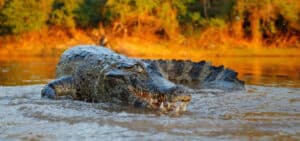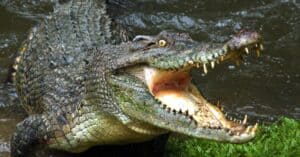Caimans are some of the largest reptiles in the world and are one of the closest species comparable to modern-day dinosaurs. Caimans can be small or large, but all species are feared apex predators in the waters they inhabit. Caimans live in Central America, South America, Florida, the Caribbean, and Mexico. They are members of the order of Crocodilia, which contains the families of Gavialidae, Crocodylidae, and Alligatoridae. Caimans belong to the family of Alligatoridae but fall into their sub-family of Caimaninae.
Large caimans are not uncommon, and some species come close to being the largest member of the Alligatoridae family. Let’s learn about the largest caiman species and how they size up compared with other giant reptiles.
The Largest Caiman in the World Today
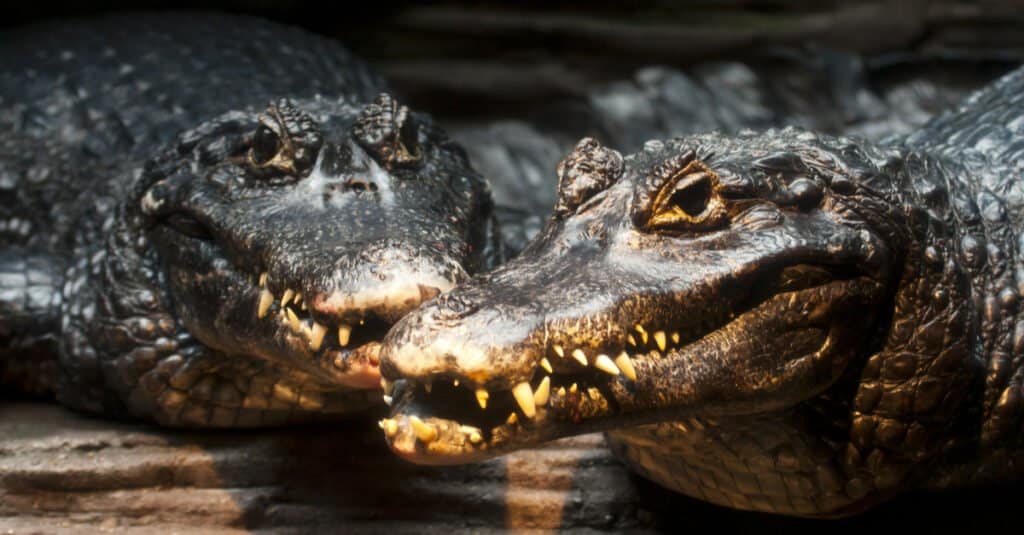
Black caimans can reach up to 14 feet in length.
©Glenn Young/Shutterstock.com
Black Caimans are the largest caiman species on Earth today. Sizes of this species vary, but most black caimans range from 7.3 to 14.1 feet (2.2 to 4.3 meters) long. Caimans’ sizes vary, and you will find a variety of sources saying black caimans can reach up to 20 ft (6.1meters). The largest official black caiman measured was around 14 feet (4.2 meters), but sightings of larger ones have been unofficially reported.
The largest member of the crocodilian family ever officially recorded was the saltwater crocodile. Lolong is a Saltwater crocodile that measured 20.3 feet (6.1 meters) and weighed more than two tons. The largest American alligator on record weighed 1,380 pounds and was captured in 2012.
Black caimans may reach 20 ft, but no animal is yet to be measured of that size. Visual evidence from people who study Crocodilia is all that shows they are capable of getting to that size. The black caiman is still one of the largest caiman and Alligatoridae members.
Types of Caiman and Their Sizes
Caiman are members of the Caimaninae family, and there are six different species in this subfamily. Caimans’ main family is Alligatoridae, and they belong to the order of Crocodilia. They are native to Central and South America, preferring warmer climates. Marshes, swamps, rivers, and lakes are habitats they inhabit. Caimans are apex predators and dominant hunters in the waters they inhabit.
Black Caiman (Melanosuchus niger)
The black caiman is one of the largest extant species in the order of Crocodilia. They have an all-black coloration, but younger specimens will have more lively colors. The black caiman can be found in South America and lives in the Amazonian rivers. They are the largest predator in their range, feeding on fish, land mammals, and every other caiman. This species is the largest of all caiman and is a dominant apex predator that hunts at night.
Broad-snouted Caiman (Caiman latirostris)
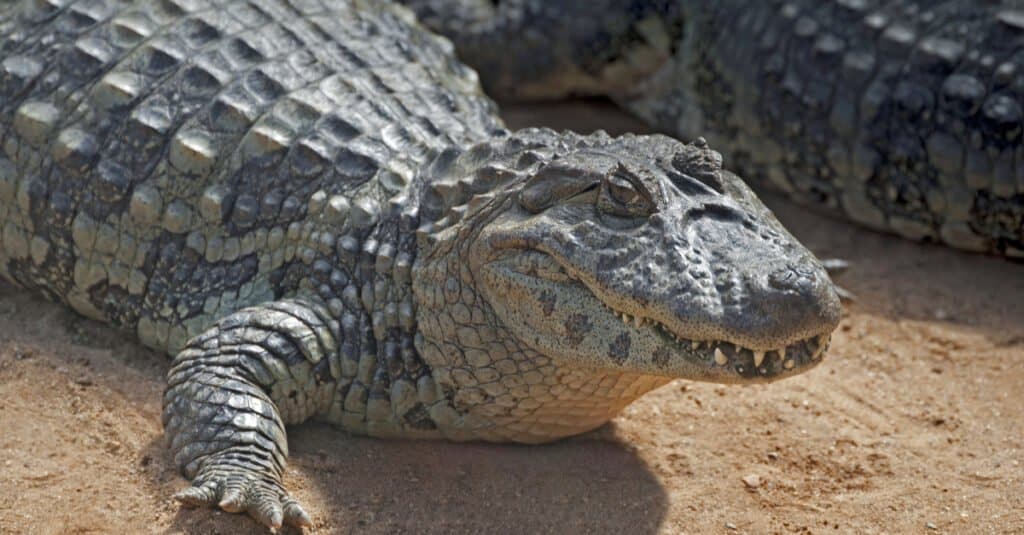
Broad-snouted caimans can reach up to 8.2 feet long.
©Ricardo de Paula Ferreira/Shutterstock.com
Broad-snouted caimans live in South America within Brazil, Argentina, Bolivia, Uruguay, and Paraguay. Freshwater habitats like marshes, swamps, and other slow-moving waters are where they can be found. Adults range from 6.6 to 8.2 ft (2 to 2.5m)long. Rare sightings have occurred of some of these species reaching 11 ft (3.5 m) long. This caiman is recognized and known for its broad, thick snout.
Spectacled Caiman (Caiman crocodilus)
The spectacled caiman is also known as the white caiman, common caiman, or speckled caiman. On average, they grow to a length of 4.6 to 8.2 ft (1.4 to 2.5 meters) and weigh between 15 to 88lbs (7 to 40kg). Spectacled caimans live in South America and Mexico.
Yacare Caiman (Caiman yacare)
Yacare Caiman is similar to the Spectacled caiman but is slightly larger. They average 8.2 to 9.8 feet (2.5 to 3 meters). In Brazil, Bolivia, and Paraguay they inhabit wetlands, rivers, and lakes. This caiman prefers water with high vegetation, which is used to hide.
Smooth-Fronted Caiman (Paleosuchus trigonatus)
Smooth-fronted caimans are also called the Schneiders dwarf caiman. On average, they are small, but the largest of this species was recorded to be 8ft 6 inches long (2.6 meters). The smooth-fronted caiman is 5.5 ft to 7.5 ft (1.7 to 2.3 meters. Females are smaller and rarely grow larger than 4.7ft (1.4 ft)
Cuvier’s Dwarf Caiman (Paleosuchus palpebrosus)
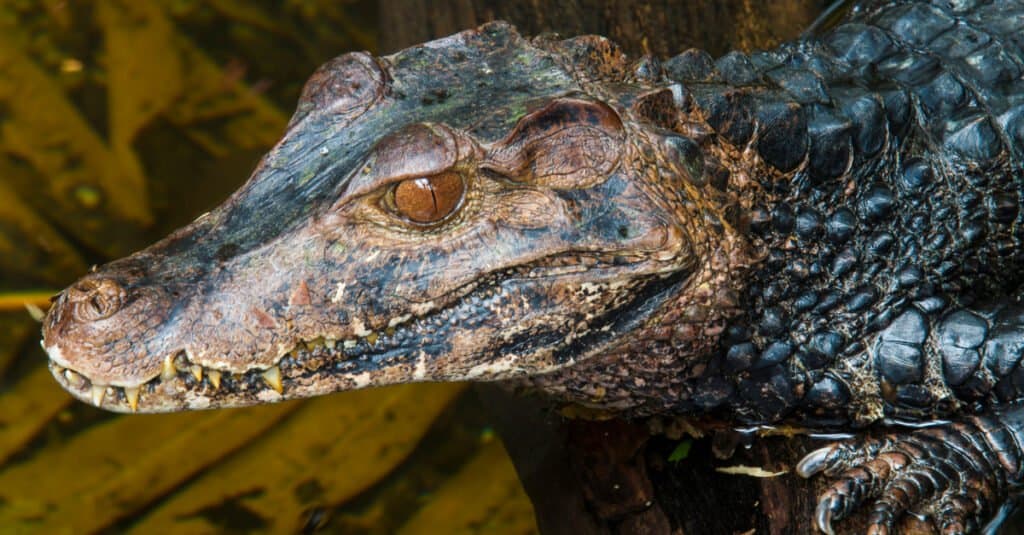
Cuvier’s Dwarf Caiman grows to about 4.6 feet.
©Danny Ye/Shutterstock.com
Cuvier’s Dwarf Caiman is the smallest of all caiman. Males average a length of 4.6ft (1.4m), and females only grow to 3.9ft (1.2m). Since they are so small many reptiles enthusiasts will keep this caiman as a pet, but it is not recommended. They need expert care and can be dangerous.
Caimans vs. Alligators vs. Crocodiles

Caimans, alligators, and crocodiles are all members of the order Crocodylia. Their families are different as caimans and alligators are in the family of Alligatoridae, and crocodiles are in the family of Crocodylidae. Alligatoridae have broader snouts and an overbite. Alligators are also cold-tolerant, but crocodiles can tolerate waters with higher salinity.
The size of the alligator, crocodile, and caiman will depend on the species. The American alligator, black caiman, and saltwater crocodile all can exceed 13 feet in length, but the saltwater crocodile is the largest on average.
Alligators have U-shaped mouths, and crocodiles have v-shaped mouths. The range, diet, habitat, and lifestyle are helpful in identifying one type from the next. Looking for critical differences between the two species, like mouth shape and coloring, is helpful.
The Largest Prehistoric Caiman Ever
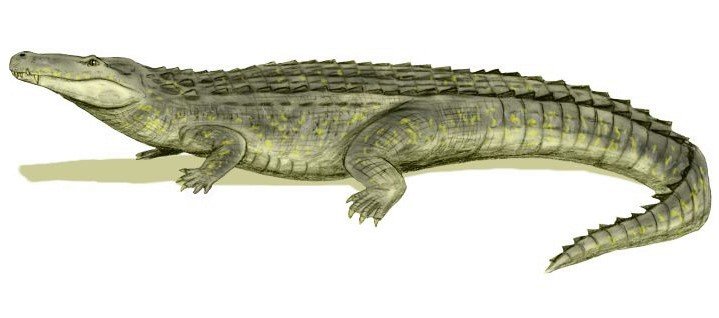
Pencil drawing of Purussaurus brasiliensis, a 12 m long alligatoridae from the Miocene of Brazil.
©Nobu Tamura (http://spinops.blogspot.com) / CC BY 3.0 – License
The Purussaurus is the largest prehistoric caiman and could reach more than 30 feet in length!
Caiman, alligators and crocodiles have roamed the earth and remained a top predator for millions of years. The Purussaurus is an extinct genus that has left behind fossil records to show us how large they got. Purussaurus is a caiman species that lived over 8 million years ago in central-south America. They are the largest known species of Caiman reaching 33 to 39 feet (10 to 12 meters)in length. What is most impressive is that with fossil records and computer generation, scientists believe their massive bite force could reach 69,000 Newtons. That’s more than four times the bite force of today’s most powerful crocodiles!
The photo featured at the top of this post is © Danny Ye/Shutterstock.com
Thank you for reading! Have some feedback for us? Contact the AZ Animals editorial team.




